Performing an SSI Investigation: Facilitator Notes
AHRQ Safety Program for Surgery
Slide 1: Performing an SSI Investigation
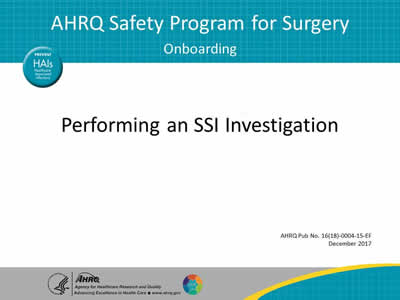
Say:
In this module, you’ll learn about performing a surgical site infection or SSI investigation.
Slide 2: Learning Objectives
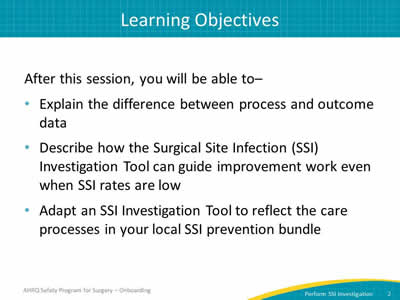
Say:
Here are the objectives.
We want to distinguish between process and outcome measures, describe how the SSI investigation tool can guide improvement work even when SSI rates are really low, and adapt an SSI investigation tool to reflect the care processes in your SSI prevention bundle, because we know that there is not one standardized SSI bundle. Hospitals have their own bundles, so you want to focus on what process measures you put into your bundle.
Slide 3: Readiness Bridge
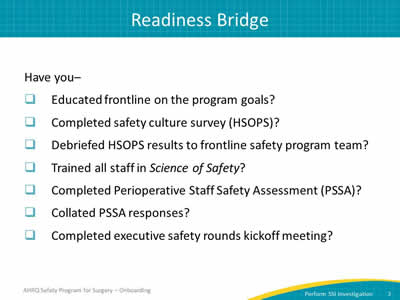
Say:
So first, before we get into the SSI Investigation, let’s see where your teams are—we call it the readiness bridge. This is to help you think about where you are right now in the process.
First, is your frontline staff aware of this safety program for surgery? Let them know what we are all doing to prevent SSIs. Let them know what CUSP, the Comprehensive Unit-based Safety Program, is within the safety program for surgery.
Second, have you completed a safety culture survey? This is the Hospital Survey on Patient Safety Culture or HSOPS survey. After administering the survey and getting your results, have you debriefed your frontline safety program team members?
Third, have staff members received the Science of Safety training? Have they viewed the Science of safety video?
Next, has your staff completed the Perioperative Staff Safety Assessment? Responses must also be collated and shared with staff. Results can be shared in your kickoff meeting or the next meeting with your executives in safety rounds.
This review of the steps helps teams to think about where they are in the safety program and solidify current tasks.
Note:
HSOPS stands for the Hospital Survey on Patient Safety Culture.
Ask:
Where are your teams at this point?
Which of the above steps are complete?
Slide 4: Assess Your Performance
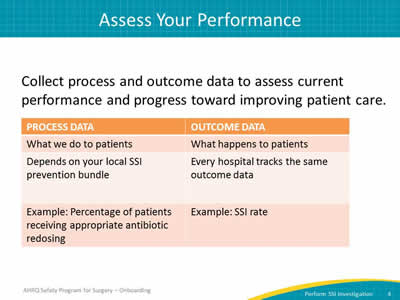
Ask:
So what is the SSI Investigation?
Say:
It is a method of assessing your team’s performance.
Ask:
How do you do that?
Say:
You will evaluate process measures rather than outcome data.
Ask:
What is the difference between these two?
Say:
The process measures are what we do to patients to prevent harm. The outcome data is what happens to those patients, such as an SSI.
Your process measures depend on your local SSI prevention bundle. The outcome data is your surgical site infection rate.
But process measures are local; each unit is different. Because there’s no one SSI bundle, each group will create its own bundle. Thus, units will have different process measures.
For example, one process measure is antibiotic redosing. Others might include chlorhexidine preoperative washcloths or liquid soap. You want to collect both process and outcome data. This will help you assess your performance and progress toward improving patient care and ultimately decreasing those surgical site infection rates, regardless of your current rates (already low or elevated).
Slide 5: Donabedian Process
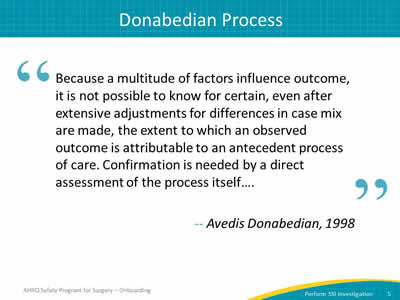
Say:
This quotation illustrates the importance of process measures. “Because a multitude of factors influence outcome, it is not possible to know for certain, even after extensive adjustments for differences in case mix are made, the extent to which an observed outcome is attributable to an antecedent process of care. Confirmation is needed by a direct assessment of the process itself.”
And as we know for our SSI bundles, a lot of processes are in place.
Avedis Donadebian (1919–2000) was the physician and founder of the study of quality in health care and medical outcomes research, most famously as a creator of the Donabedian Model of Care.
Slide 6: Identify Defects With SSI Investigation Tool
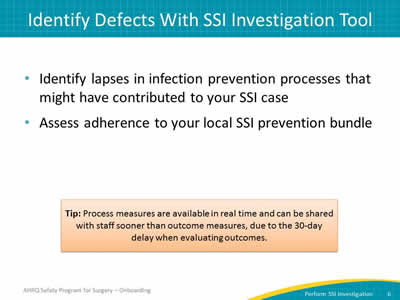
Ask:
So how do we improve?
Say:
We want to uncover defects with the SSI investigation tool. You want to identify the lapses in infection-prevention processes that might have contributed to your SSI case by assessing adherence to the process measures in your local SSI prevention bundles.
Ask:
What practices did you put in place to prevent your surgical-site infections?
For instance, what did the PSSA responses indicate would cause the next surgical site infection?
Did you put a different process in place because of what you learned?
What overall bundle did you put in place?
Say:
Because that bundle contains all your process measures, that’s what you want to look at to see how compliant you are with your process measures. When you look at process measures versus the outcome measures, you can get your process measures on a real-time basis and get those back to your staff quicker than you can with those outcome measures because of that 30-day delay when looking at the outcome measures. Process measures are entirely owned internally, while outcome measures have external impacts.
Slide 7: Identify Defects With SSI Investigation Tool
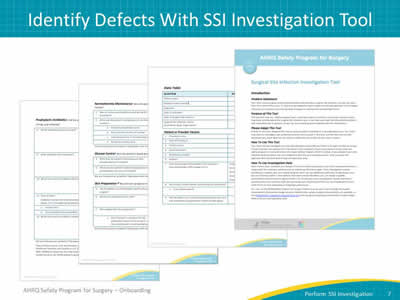
Say:
The SSI Investigation Tool can support your local bundle intervention.
Slide 8: Patient or Provider Factors
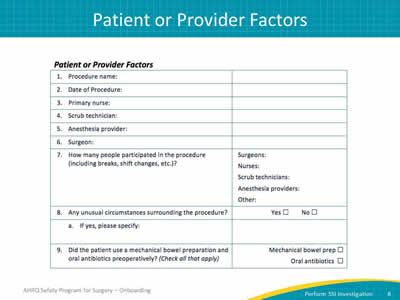
Say:
This involves both patient or provider factors, and offers a way to investigate SSIs. You can alter this tool to fit your SSI bundle needs.
Slide 9: Normothermia Maintenance
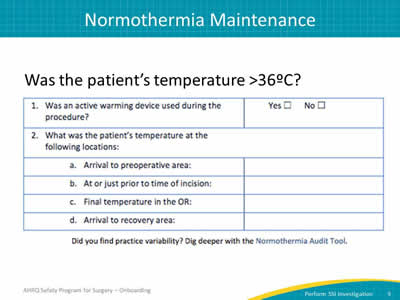
Say:
Here are some single-process measure audits. You can change these forms to meet your local needs. They are available in Microsoft Word format for easy customization.
This is an example of the Normothermia Audit Tool. It’s just one process measure initially developed for the colorectal operating room.
Slide 10: Glucose Control
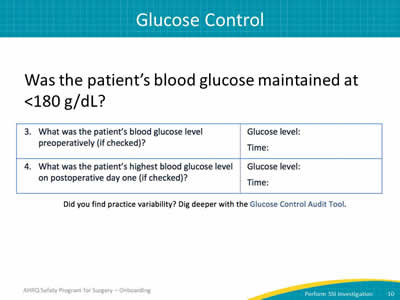
Say:
Another example is Glucose Control.
Slide 11: Skin Preparation
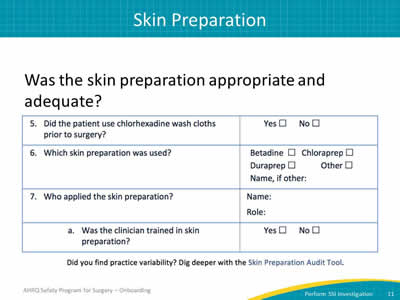
Say:
One intervention involved appropriate and adequate skin preparation.
Slide 12: Prophylactic Antibiotics
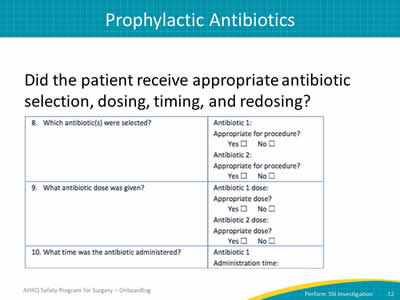
Say:
These are examples of some of the process measures Johns Hopkins Hospital focused on, because of frontline staff observations.
Slide 13: Prophylactic Antibiotics
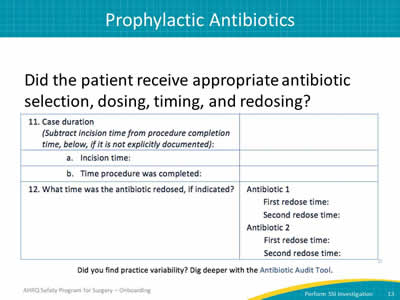
Say:
For many hospitals the frontline staff observed inconsistencies in these care practices. This portion of the SSI Investigation Tool asks if the patient received the appropriate antibiotic selection, at the appropriate dosage and timing, as well as the appropriate redosing schedule.
Slide 14: Adapt the SSI Investigation Tool
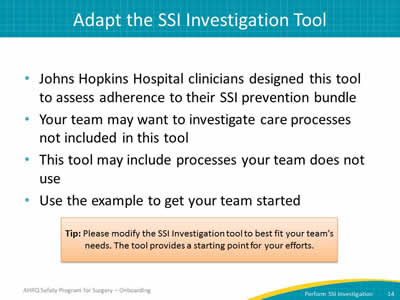
Say:
You can use these single audit tools at baseline first before you make any system changes. For example, your team decides that patients are coming out of surgery cold, and that needs to be addressed. The team can use this tool first to determine the baseline rates of normothermia before making any system changes. Then use this tool again after you implement a system change to measure and trend your improvement efforts. It should be used shortly after the change and again over time to continuously track your compliance.
Again, these are just some of the process measure tools available to you. Use these at any time to evaluate your work area’s compliance with any of the process measures that you put into place.
Slide 15: What Your Team Can Do
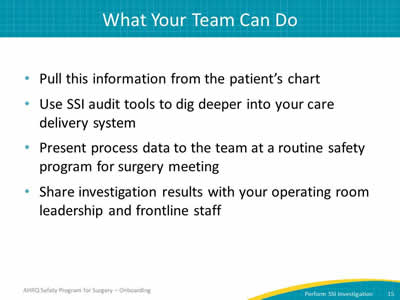
Say:
Your team can extract this information from the patient’s chart. However, the SSI audit tools help you dig deeper into your care delivery system.
Referring back to the beginning, we already know that most of us are at 95 percent or better with any of the SCIP (Surgical Care Improvement Project) data out there, yet our patients are still getting infections. So, let’s dig deeper into the local process measures that your front line has addressed and what you might consider as your SSI bundle.
Once you do that, present this process data compliance to your team at your monthly routine SUSP meetings and share these results with everybody on the front line. That includes regular staff meetings and OR leadership meetings. You could even post graphs in conference rooms or anywhere staff can see it. Sometimes the best places to post things are in the bathrooms. For whatever reason, staff really read what’s posted there. One way or another, make sure ALL your staff see how they’re doing with the process measures and what the outcomes are for the patients.
Evidence shows that if staff members see this data, they are driven to improve. They start to own those results. Your care providers want to provide the best care. If you can show them graphs and how they’re trending, they will make improvements. Share results as frequently as you can, perhaps monthly or quarterly.
Slide 16: Next Steps
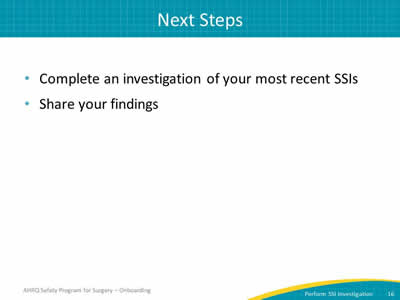
Say:
Next, investigate your most recent SSI using the SSI investigation tool. Or use some of those single audit tools to assess your baseline and help trend the process measures that you put into place.
Most importantly, share these findings with your frontline staff.



